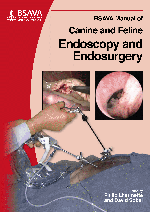
Full text loading...

PLEASE NOTE THAT A MORE RECENT EDITION OF THIS TITLE IS AVAILABLE IN THE LIBRARY
Exploratory laparotomy is a major invasive procedure, often carried out on a sick or debilitated patient. Clinicians may hesitate to put their patient through such a procedure, and may therefore rely on incomplete information from indirect observations such as blood tests and other imaging studies to form their diagnosis. Owners may also be reluctant to subject their pet to major surgery 'just to get a sample'. Laparoscopy is a minimally invasive surgical technique used in veterinary practice for diagnostic procedures and surgical treatment of a variety of conditions. It is a very safe technique if the basic rules are followed. Laparoscopy enables surgeons to carry out a thorough visual inspection of the abdominal cavity and obtain tissue samples quickly, with minimal trauma to the patient. This chapter explains Instrumentation; Anaesthetic considerations; Procedure; Biopsy; Feeding tube placement; Gastropexy; Ovariohysterectomy; Ovariectomy; Ovarian remnant removal; Cryptorchid surgery; Laparoscopic-assisted cystoscopy; Cholecystectomy; Other potential surgical procedures; and Complications.
Rigid endoscopy: laparoscopy, Page 1 of 1
< Previous page | Next page > /docserver/preview/fulltext/10.22233/9781905319572/9781905319572.11-1.gif

Full text loading...






























